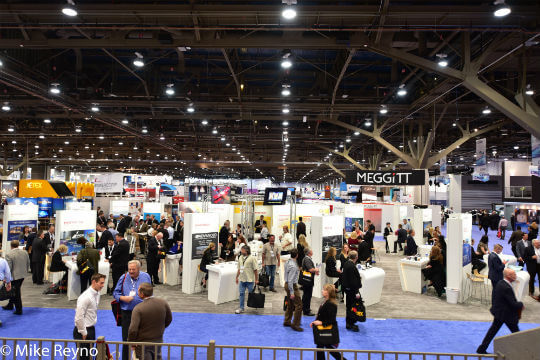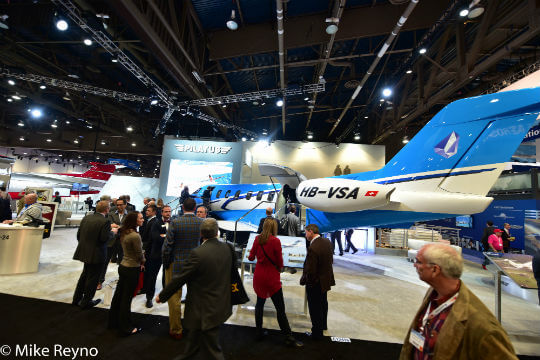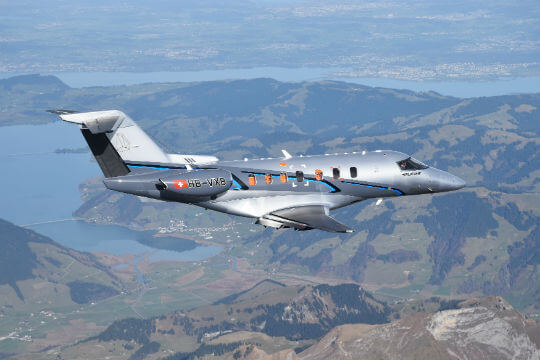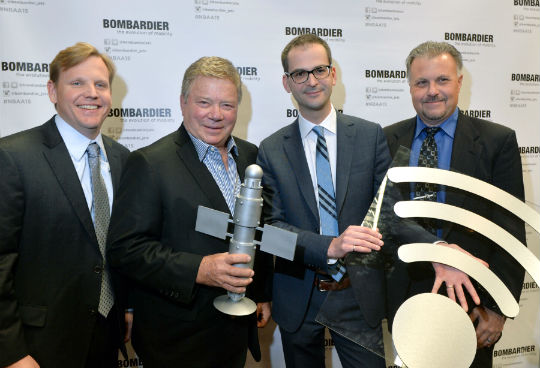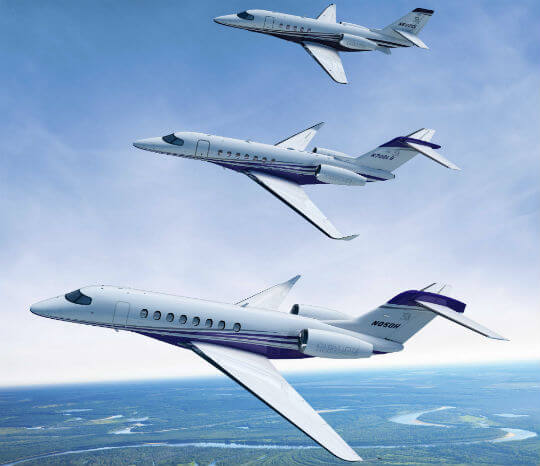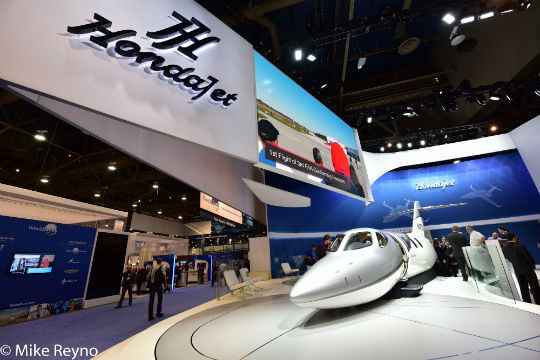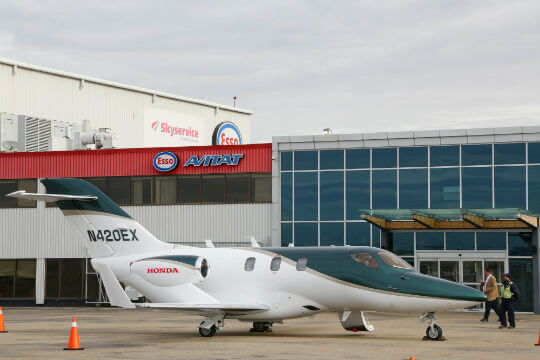About 1,000 exhibitors packed the Las Vegas Convention Center to showcase the latest and greatest products and innovations for business aviation. Mike Reyno Photo
Business aviation’s largest annual event returned to Las Vegas, Nev., from Nov. 17 to 19, 2015. With more than 27,000 people in attendance, the National Business Aviation Association’s 2015 convention and exhibition featured the who’s who of the industry.
A number of organizations used the press day on Monday, Nov. 16, to brief media representatives on the status of key projects and priorities. Overall, the mood was positive, with the common message being that business aviation is focusing once more on the rebounding U.S. market.
“We’re having a good year at Gulfstream,” reported Scott Neal, the OEM’s senior VP, worldwide sales and marketing. “The second quarter this year was our strongest in seven years, with the third quarter being our best since 2011.”
Gulfstream president Mark Burns reported that third-quarter 2015 revenues and earnings were up by 4.7 per cent and 8.1 per cent, respectively, over the same quarter of last year. The Savannah, Ga.-based manufacturer also said it had delivered 116 aircraft to customers by the end of September, including 89 large-cabin and 27 mid-cabin models. Gulfstream’s current backlog sits at US$13.559 billion.
Gulfstream president Mark Burns reported that third-quarter 2015 revenues and earnings were up by 4.7 per cent and 8.1 per cent, respectively, over the same quarter of last year. Mike Reyno Photo
Neal noted that Gulfstream continues to receive orders for every model in its business jet portfolio, ranging from the G150 all the way up to the flagship G650ER. The first G650 was delivered in December of 2012, he said, and today the company has delivered more than 140 of the jets to customers around the world. Most of the recent orders are for the extended range version, which is reportedly a strong performer in every geographical market.
Gulfstream’s all-new G500 made its NBAA debut this year, flying from Savannah to Las Vegas in four hours and 36 minutes, according to Dan Nale, senior vice president, programs, engineering and test. He provided a program update on both the G500 and G600, noting that both are on track for entry into service in 2018 and 2019. Gulfstream is emphasizing the high-speed range capabilities of both new jets, combined with what the company calls “industry-leading fuel efficiency.” The G500 and G600 feature Gulfstream’s Symmetry Flight Deck with active control sidesticks.
Burns said Gulfstream will continue to focus on improving its product support, and will add more mobile service units to its fleet in the coming year.
Representatives from Pilatus Aircraft were in a celebratory mood on Nov. 16, following the first flight of the second PC-24 twinjet prototype earlier that same day. The jet took off from Buochs Airport in Switzerland and flew for a total of 82 minutes. The aircraft, designated PO2, will be sent for various systems tests in the United States and Canada, including cold weather and icing evaluations.
In the Swiss OEM’s first press conference since the PC-24 roll-out in August 2014, Pilatus Aircraft CEO Markus Bucher noted that North America is home to 70 per cent of the PC-12 fleet, and the OEM expects a similar success in that market for its first jet.
Overall, the mood at NBAA was positive, and the show floor was busy. The Pilatus booth was no exception, with the company showcasing both the PC-12 and the PC-24 jet. Mike Reyno Photo
Designed with the capability to access short, unimproved runways, the PC-24 has inherited many functional qualities from its single-engine turboprop predecessor. Speaking of the PC-12, Tom Aniello, Pilatus’ VP of marketing, said the company will soon deliver its 1,400th aircraft from that family.
“We have made many subtle but important changes to the 2016 PC-12 NG,” continued Aniello. He said the new PC-12 NG is five knots faster than its predecessor, with a top cruise speed of 285 knots, thanks to several effective aerodynamic refinements. He pointed to a flush entry door handle, streamlined flap actuator fairings, antenna realignment, aileron servo tab fairings, and wing trailing edge gap sealing as being responsible for the performance improvements.
But, while these changes may be subtle, there is another that is definitely not: the addition of a five-blade Hartzell graphite composite propeller in the 2016 model boosts ramp appeal while delivering real improvements such as reduced takeoff distance, shortened climb to altitude time, less cabin sound and vibration, and lower propeller maintenance costs.
Pilatus is reportedly looking at bringing some PC-24 work to its Broomfield, Colo., plant. The site is now a completions centre for PC-12 aircraft, which arrive green from the Swiss factory. The PC-24 is currently on track for certification in mid-2017, with joint certification anticipated from the Federal Aviation Administration (FAA) and European Aviation Safety Agency (EASA).
The second PC-24 twinjet prototype is pictured here on its maiden voyage on Nov. 16. Pilatus Photo
Embraer Executive Jets was also celebrating at NBAA 2015, as the company marked its 10th anniversary as a business jet manufacturer. President and CEO Marco Tulio Pellegrini said the company is proud to offer a fully certified product portfolio, from the Phenom 100E (which is recognized as a proven pilot training jet for airlines such as Emirates) to its largest and most luxurious offering, the Lineage 1000E.
Embraer brought six jets to NBAA including the Legacy 450, which has just undergone improvements to extend its range to 2,900 nautical miles (nm), an increase of 325 nm over the recently-certified aircraft. To achieve this, the manufacturer modified the wing to allow for increased fuel storage and made some changes to the fuel control unit, avionics and aircraft flight manuals. The changes will be retrofittable to the first model of the Legacy 450, with the new aircraft price tag remaining unchanged for the moment at US$16.57 million. The first Legacy 450 with extended range is expected to be delivered in the third quarter of 2016.
The Legacy 450 and 500 were the first aircraft to introduce the six-foot, stand-up cabin and represent a “new paradigm” in aircraft systems with the inclusion of full fly-by-wire, sidestick controls, enhanced vision system, compact head-up display, auto throttles and auto brakes, according to Pellegrini.
Embraer brought six jets to NBAA including the Legacy 450, which has just undergone improvements to extend its range. Here, company president and CEO Marco Tulio Pellegrini poses with the Legacy 450. Embraer Photo
In its 2016 to 2025 market forecast, Embraer predicts a need for 9,100 jets worth US$259 billion over the next decade. The North American market will account for 54 per cent of that total, believes the Brazilian OEM, with the small and medium jet segments expected to represent the majority of the market. Embraer Executive Jets currently has 930 jets in operation in 60 countries.
French manufacturer Dassault Aviation’s new flagship, the tri-jet Falcon 8X, made its NBAA debut in Las Vegas. Since its first flight last February, the flight test program has accumulated more than 380 hours on three aircraft. The aircraft is more than two thirds of the way through the FAA and EASA approval process, according to Dassault.
A descendant of the Falcon 7X, the ultra-long-range 6,450 nautical mile Falcon 8X was unveiled in May 2014 at the European Business Aviation Convention & Exhibition, and rolled out on Dec. 17 of that year. Dassault says the 8X will offer the greatest range and the longest cabin of any Falcon, and the largest selection of cabin configurations in the industry. Deliveries are set to begin in the second half of 2016.
In parallel with flight tests, the OEM is ramping up production at its final assembly facility in Mérignac, near Bordeaux, France. Eight aircraft are currently in various stages of assembly at that plant, and ground was recently broken for the construction of a new six-bay hangar to handle maintenance and repair work for the 8X, the 7X and other Falcon models.
Dassault’s Little Rock, Ark., completion facility is handling cabin and equipment outfitting and painting. The OEM recently expanded that location to add 350,000 square feet of production space, which includes a hangar dedicated to the Falcon 5X and 8X.
With more than 27,000 people in attendance, the National Business Aviation Association’s 2015 convention and exhibition featured the who’s who of the industry. Mike Reyno Photo
In related news, Dassault announced it will expand its one-day Falcon Cabin Familiarization Training program to include the new Falcon 8X.
The manufacturer also introduced its FalconEye at NBAA 2015, which it bills as the “first Head-Up Display (HUD) system to combine synthetic, database-driven terrain mapping and actual thermal and low-light camera images, providing an unprecedented level of situational awareness to flight crews.”
NBAA’s annual conference is no stranger to VIPs and celebrities. This year, Bombardier brought actor William Shatner to the show to vouch for its new worldwide high-speed in-flight connectivity solution. Dubbed Bombardier WAVE (Wireless Access Virtually Everywhere), the manufacturer has worked with Honeywell and Inmarsat to complete testing and validation of its new in-air Internet productivity tool, which is installed on Bombardier’s Global aircraft experimental test bed.
Bombardier picked up Shatner in California and flew him to Las Vegas so he could evaluate WAVE’s capabilities. “I got on this beautiful Global and called my office and asked them to send me a large sizzle reel from my movie, The Ride,” Shatner told reporters. “It was instantly sent to me while I was in the air.”
Bombardier said WAVE uses satellite communications technology to deliver worldwide coverage and in-flight Internet access at speeds “never before seen in business aviation.” Passengers can reportedly stage a videoconference, browse the Internet or stream online shows while in the air. WAVE will be offered as an option on all new 2016 Global business jets, while a retrofit package is available for Global Express, Express XRS, 5000 and 6000 aircraft.
Bombardier brought actor William Shatner to the show to vouch for its new worldwide high-speed in-flight connectivity solution. Bombardier Photo
In related news, Bombardier and NetJets Inc. were also celebrating the entry-into-service of the new Challenger 650 aircraft. On static display at Henderson Executive Airport throughout the NBAA show, NetJets’ first Signature Series custom-built Challenger 650 also marks Bombardier’s 1,000th Challenger 600 series aircraft to enter into service.
Also on static display at the Bombardier booth was a cabin mock-up of the Global 7000 aircraft, first announced in 2010. Tim Fagan, manager of industrial design for Bombardier Business Aircraft, told Skies it is the company’s new flagship business aircraft, being the largest in its segment with the longest range.
“There is a huge focus on taking care of the passenger within the cabin and meeting all of the different requirements of the different types of operations,” said Fagan. With four distinct living zones for business, dining, entertainment and sleep, the Global 7000 offers a “home away from home and an office in the sky” for long-range travel.
Fagan noted that the Global 7000 incorporates lots of new touches. “We’ve expanded the windows by 80 per cent to bring a lot of natural light into the aircraft, and we’ve spaced them evenly throughout so there is a window for every seat, and a window centered on every table. The lavatory is a private en suite in the back, and is designed to maximize space.”
Up front, he continued, the flight deck will feature a new fly-by-wire system and a crew jumpseat, with a 20 per cent larger galley. The Global 7000 has a 7,400 nm range with eight passengers, and is capable of flying non-stop from New York to Beijing. The airframe will be manufactured and assembled at Bombardier’s plant in Downsview, Ont., and completed in Montreal. Deliveries are projected for the second half of 2018.
Textron Aviation was at NBAA in full force, with 11 of its business jet and turboprop aircraft on static display. The centerpiece of the company’s exhibit was its new Cessna Citation Longitude, with a full-size ground test article (complete with full interior) making its public debut in the super-midsize business jet category.
Textron announced plans to build a big sister for its Latitude (top) and Longitude (middle) jets. The planned Cessna Citation Hemisphere (bottom) will be the largest member of a new large-cabin Citation family. Textron Image
At a media briefing, Scott Ernest, Textron Aviation president and CEO, noted that the company has certified eight different products in the last three years—a result of its commitment to “aggressive product investment.”
Ernest said the Longitude was developed through an extensive customer consultation process, with feedback incorporated into the jet’s design. “With a 3,400 nm mile range, the Longitude offers higher speed and greater range at a lower ownership cost,” he noted.
The Longitude is expected to log its first flight in mid-2016, with deliveries in the second half of 2017. It’s an accelerated certification timeline that has become a Textron trademark, with the Longitude’s sister ship, the Latitude, going from first flight to certification in only 14 months.
Textron also announced plans to build a big sister for its Latitude and Longitude. The all-new Cessna Citation Hemisphere, with a 4,500 nm range and a max cruise speed of Mach 0.9 or quicker, will be the latest entrant to the large business jet category. Together, the three aircraft will make up a new large-cabin Citation family.
In the light jet category, Cessna reported the roll-out of its 100th Citation M2 business jet, less than two years after the model was certified by the FAA.
Also at the show, Textron subsidiary Beechcraft Corporation announced it has achieved type certification of the Rockwell Collins Pro Line Fusion-equipped Beechcraft King Air 350i/ER, with deliveries set to begin by the end of 2015. Both a King Air 350i and a 250 model were on display at Henderson Executive Airport.
Honda Aircraft Company also provided a program update at NBAA 2015, announcing that it had completed function and reliability testing on the HondaJet. Mike Reyno Photo
And, in related news, GE Aviation unveiled its all-new turboprop engine, which was selected by Textron to power its new single-engine turboprop (SETP). The 1,300 shaft horsepower (SHP)-rated turboprop engine is the first entry in GE’s new family of turboprop engines aimed at business and general aviation aircraft in the 850 to 1,600 SHP range. A challenger to Pratt & Whitney Canada’s (P&WC) venerable PT6 engine, GE’s new offering will reportedly offer up to 20 per cent lower fuel burn and 10 per cent higher cruise power. Textron’s new SETP is expected to seat less than 12, have a range of 1,500 nm, and cruise at speeds higher than 280 knots. GE is targeting a detailed design review for the new turboprop in 2017, followed by the first full engine test in 2018.
For its part, Pratt & Whitney Canada president John Saabas told reporters at a media briefing that the company is in a “good position.” In the last year, the engine manufacturer’s PW800 engine was selected to power Gulfstream’s G500 and G600 ultra long-range business jets, and the G500 made its first flight. In addition, type certification was achieved for the PW814GA and PW815GA engine variants.
P&WC also announced a service plan for the new engine family, called ESP PurePower PW800, at NBAA 2015.
“We are expanding PW800 applications,” said Michael Perodeau, vice president, marketing, business aviation and military programs. “The vision is to make a smaller PW800 using a small core and a larger version using a larger core. OEMs are aware of our capabilities.”
P&WC also announced it is launching the PT6A-140A turboprop engine, billing it as the most powerful and fuel efficient engine for the general aviation market. A version will also be released for the agricultural market, dubbed the PT6A-140AG.
Optimized for hot and high environments, the engines do not have mandatory time requirements for warm-up or cool-down, allowing for maximum run-time productivity and efficiency. With a maintenance schedule that can accommodate high-cycle operations, P&WC said the engines offer one of the longest time-between-overhaul intervals.
“No one understands the needs of general aviation better than we do,” said Denis Parisien, vice president, general aviation, P&WC. “There are more than 70 PT6A engine models used for over 125 different aircraft applications around the globe—a testament to the PT6A’s unmatched versatility, performance and reliability.”
HondaJet completed a world tour in 2015, making appearances in Japan, Europe and South America. Earlier, it visited Skyservice in Canada. Skyservice Photo
Honda Aircraft Company also provided a program update at NBAA 2015, announcing that it had completed function and reliability testing on the HondaJet, with more than 3,000 flight hours logged in 70-plus locations. The aircraft completed a world tour in 2015, making appearances in Japan, Europe and South America.
FAA type certification was expected “very soon,” according to company president and CEO Michimasa Fujino. He indicated that when that milestone is achieved, Honda Aircraft will host members of the media at its Greensboro, N.C., plant, where 25 aircraft are currently on the final assembly line.
The first delivery of the HondaJet was expected to be made in December, said Fujino, shortly after type certification. The company aims to deliver three to four aircraft per month in 2016, with most units going to U.S. buyers.
Fujino also indicated that HondaJet technology is “scalable,” and that other derivatives of the aircraft are likely to be developed in the future, including a possible aeromedical version. “Our goal is to make new customers realize the potential of business jets,” he said.
Although Fujino declined to quantify the company’s investment in the HondaJet to date, he admitted that Honda Aircraft Company spent more than existing OEMs during the initial phase of development, due to unique attributes such as the patented over-the-wing engine mount. With “over 100” aircraft on backlog, however, and promising potential in the U.S., Asia and Japan, he is confident in the new jet’s success.
Like other aircraft manufacturers, privately-owned Daher of France is also turning its focus to the U.S. market. “We want to be as American as European in the coming years. We have a big range of capabilities and we are convinced we can bring value to our American customers,” said deputy CEO Didier Kayat.
The OEM announced at NBAA that it would be providing a tailored support package for Part 135 operators of its TBM aircraft, in response to an increase in the number of American operators using the fast single-engine turboprop for charters. As an example, Daher representatives introduced Eric Walden at an NBAA press briefing. Walden is the CEO of Little Hawk Logistics, a charter company he founded in Virginia. Currently operating a TBM 850, Walden reported he has flown more than 200 passengers since he started operations in June 2015. Most of his trips are about an hour and a half in duration.
Walden described the TBM as a “spectacular” example of aviation engineering. “The TBM performance is amazing in all phases of flight, and translates into charter costs that are well below any other solution—at greater speed and comfort.”
In North America, Daher employs about 220 people in eight locations and generates more than US$200 million in revenue. Along with being an aircraft manufacturer, the company also specializes in aerostructures and systems, with expertise in both composites and metals. As of Nov. 15, 2015, Daher had delivered a total of 758 aircraft across its entire TBM product line.
With the U.S. market showing a renewed appetite for business aviation, OEMs were not the only ones who brought a positive outlook to NBAA 2015. About 1,000 exhibitors packed the Las Vegas Convention Center to showcase the latest and greatest products and innovations for business aviation. There should be more good news to look forward to next year, as the 2016 NBAA Business Aviation Convention and Exhibition moves to Orlando, Fla., from Nov. 1 to 3.
